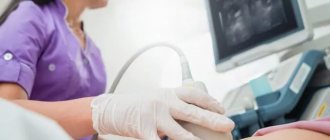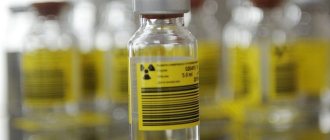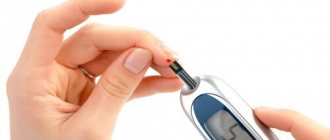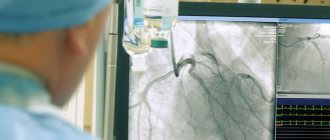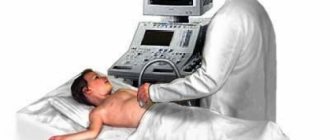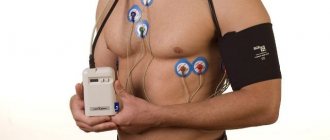CT coronary angiography of the heart is a diagnostic method for studying the vessels of the heart, aimed at determining their condition and identifying any anomalies and pathological conditions. It is considered the “gold standard” because it makes it possible to identify pathologies in the early stages of development and see even minor damage to the blood vessels of the heart.
The research method makes it possible to obtain an image of the myocardial network, the pathologies of which are considered the most common initiating factor in cardiovascular diseases. Thanks to it, it is possible to diagnose disturbances in the blood supply to the heart, narrowing and spasms of the coronary vessels, and any other disruptions in the blood supply to the middle muscular layer of the heart.
The procedure involves the use of a contrast agent. In this way, the most accurate three-dimensional image is obtained, after studying which the doctor is able to correctly diagnose and prescribe appropriate treatment.
Control CT coronary angiography after the intervention performed at JSC CELT (term 2-6 months) - 14,500 rubles.
30-45 minutes
(duration of procedure)
Advantages of CT coronary angiography of cardiac vessels in CELT
You can undergo the study at the CELT multidisciplinary clinic. We employ highly qualified specialists with over 15 years of experience. They have perfectly studied the technique of coronary angiography and have everything necessary to carry it out in accordance with international standards.
The procedure is carried out on a modern multislice tomograph, which allows you to obtain the most accurate image and identify any, even the smallest, pathological changes. For contrast, modern safe means are used that minimize any negative impact on the patient’s body.
The price of CT coronary angiography of the heart vessels in Moscow is determined individually, since it depends on the volume of contrast agent, its type and the tasks that need to be solved during the diagnostic study.
The price of coronary angiography of the heart vessels in CELT is presented in the price lists in the corresponding section of our website. You can also find out by calling us at our number. We regularly update the price list data, however, to avoid misunderstandings, we ask you to check the price by phone.
Benefits and risks of CT
Advantages
The results of computed tomography allow doctors to make the most accurate, correct diagnosis and timely prescribe treatment. Computed tomography is a non-invasive, painless diagnostic method. Carrying out CT scans very often reduces the required number of studies to a minimum and eliminates the advisability of using invasive techniques.
CT scan:
— allows you to study the state of the bone structure, soft tissues, blood vessels and individual organs layer by layer; - often used in emergency situations, for post-traumatic disorders, for suspected damage to internal organs, bleeding; — can be used if the patient has implanted medical devices of any kind; — used for control during biopsy of organs and pathological areas of the human body. X-rays from a CT scan have no immediate side effects.
Estimated risks and contraindications
The effective dose of radiation from computed tomography is minimal, however, it is always present. The radiation dose is usually specified in the study protocol. In the interests of accurate diagnosis, especially in acute cases, this risk is mitigated. Women are required to inform the referring physician and radiologist about the possibility of pregnancy. Because of the potential risk to the baby, CT scans are not recommended for pregnant women unless there are specific medical indications. It is extremely rare, but allergic reactions to a contrast agent that contains iodine do occur. In such cases, PATERO CLINIC has all the necessary means to stop such reactions.
Manufacturers of intravenous contrast media do not recommend that mothers breastfeed for 24 to 48 hours after receiving or administering contrast media.
Types of coronary angiography, advantages of CT
The purpose of coronary angiography is to visualize the blood vessels of the heart, which is made possible by filling them with a contrast agent. Thus, the doctor gets the opportunity to clearly examine the lumens of the blood arteries and their internal walls. Urografin solution is most often used as a contrast agent.
Experts distinguish three types of coronary angiography, including general, selective and. In the first case, an X-ray machine is involved, and its disadvantage is that the contrast must be injected directly into the vessels of the heart, which significantly complicates the procedure and increases the risk of complications after it.
Selective coronary angiography is a more “advanced” version of the general one. The process focuses on one or more vessels whose condition needs to be determined. As for CT coronary angiography (or, as it is also called, MSCT), it is the most optimal method, since it is safe, effective and allows one to obtain reliable data.
Multislice computed tomography allows you to study not only the condition of the heart vessels, but also its valves. Its cost is quite high, and it can only be carried out in those clinics that have the appropriate equipment - a multislice computed tomograph.
The process uses contrast agents based on iodine compounds, after which scanning and image creation begin. The advantages of this type of coronary angiography are difficult to overestimate:
- minimal invasiveness;
- no need for hospitalization of the patient;
- minimal risk of complications;
- the ability to identify hidden diseases;
- the ability to diagnose pathologies in the early stages of development;
- determination of the type of atherosclerotic changes;
- the ability to evaluate the effectiveness of bypass surgery.
Indications:
- identified foci of calcification (calcification) of the valvular apparatus of the heart, cardiac muscle (myocardium) or serous membrane of the heart (pericardium) when performing computed tomography of the chest;
- old post-infarction scars, aneurysms of the great vessels or suspected presence of blood clots in the cavities of the heart;
- high calcium index values when assessing coronary calcification (CT “calcium scoring”);
- suspicion of abnormal development of heart vessels or heart valve insufficiency, for example when performing echocardiography;
- chest pain of unknown etiology, atypical pain;
- the appearance of primary or repeated symptoms of angina pectoris;
- deviation from normal indicators of electrocardiography, stress tests, laboratory tests;
- the need to assess the blood supply to the heart muscle (myocardium) after surgical interventions (coronary artery bypass grafting, coronary artery stenting).
[/td]
The high prevalence of cardiovascular diseases and the first place among the causes of mortality in developed countries makes preventive measures and early diagnosis of heart disease . MSCT of the coronary arteries can be performed as a screening during a preventive (dispensary) examination of a person. Atherosclerosis of the coronary arteries is the main cause of the development of coronary heart disease (coronary heart disease) and myocardial infarction. Modern medicine has a wide range of diagnostic capabilities. And with the advent of high-speed multislice computed tomography (MSCT), a completely new, unique opportunity has emerged for non-invasive assessment of the condition of the coronary arteries, which does not require hospitalization of the patient to a hospital for a complex and unsafe surgical procedure (angiography).
MSCT examination takes only a few minutes, does not require additional preparation, and does not cause pain or emotional anxiety. In addition to assessing the condition of the heart vessels ( coronary “tree” ), MSCT of the coronary arteries provides the doctor with additional equally important information, which allows him to assess the condition of the heart as a whole, and develop tactics for further examination and treatment. MSCT allows you to evaluate the morphological structure of an atherosclerotic plaque , study the valve structures of the heart (calcification of the leaflets, anomalies of valve development), identify myocardial lesions (hypertrophy, scars), and assess the condition of the cavities of the heart and pericardium. Valuable information is provided by determining the function of the left ventricular myocardium with identifying areas of impaired contractility.
Indications and contraindications for CT coronary angiography
Carrying out multislice computed tomography aimed at studying the coronary vessels is advisable in the following cases:
- diagnostic studies as part of preoperative preparation for surgery on the heart or its vessels;
- the development of Kawasaki syndrome in a child, characterized by damage to the blood vessels of the heart with a high risk of blood clots and aneurysms, ruptures of the vessel walls;
- development of a clinical syndrome characterized by a feeling of discomfort in the sternum (angina) during the course of treatment for myocardial infarction;
- suspicions of inflammatory processes of the inner lining of the heart of viral etiology;
- as part of preoperative preparation for any surgical intervention in patients who have suffered a myocardial infarction for an unknown reason;
- lack of the desired effect from conservative treatment of pathological conditions such as angina pectoris, cardiac arrhythmia;
- sudden cardiac arrest for unknown reasons;
- the patient's upcoming organ transplantation;
- recent blunt traumatic injuries to the chest;
- any pathological processes affecting the aorta or coronary blood vessels.
- The procedure has a number of contraindications, since it involves the use of a contrast agent. These include the following:
- pregnancy and lactation in women;
- the patient’s weight is higher than the norm specified in the technical documentation for the tomograph;
- individual intolerance to contrast agents;
- severe form of diabetes mellitus;
- severe liver and kidney failure;
- thyroid diseases;
- any disturbances in the frequency and rhythm of heart contractions - arrhythmia;
- an increase in heart rate from 90 beats per minute - tachycardia.
Coronary angiography (coronary angiography - CG)
Dear patients!
At the National Medical Research Center for Cardiovascular Surgery named after. A.N. Baculeva coronary angiography on an outpatient basis is performed on a paid basis.
Cost 35,000 rubles
For more detailed information, call the multi-line phone from 9:00 to 17:00
Address: 121552, Moscow, Rublevskoye sh. 135
Coronary angiography
(coronary angiography - CG) is the “gold” standard for diagnosing coronary heart disease.
This is an invasive research method. Images of the arteries that supply the heart, the coronary arteries, are achieved by injecting them with a contrast agent through special catheters. Catheters are inserted into the heart vessels through a small puncture in the wrist or, if necessary, through the groin area. Coronary angiography provides the doctor with all the necessary information about the condition of the coronary arteries.
Considering that radial access (through the wrist) is currently used to perform coronary angiography, bed rest after the procedure is not required. The duration of the study itself is 15-20 minutes.
Hospitalization at the Center
The patient arrives at the Center on an empty stomach. After completing the documents, he is placed in the ward and examined by the attending physician. You must have blood tests with you for HIV, hepatitis and syphilis (Wassermann reaction) mdash; no more than 14 days old. In the absence of own results of instrumental examination, an electrocardiogram and ultrasound of the heart (echocardiography) are performed.
Performing coronary angiography
Immediately after this, the patient is transferred to the cath lab to perform coronary angiography. The procedure is performed under local anesthesia, as it does not create serious discomfort during execution. The patient has the opportunity to communicate with the specialist performing the procedure. To perform CG, our Center uses the most modern contrast agents (Visipak, Omnipaque, Xenetics, etc.), which minimizes the risk of allergic reactions. Novocaine is most often used to perform local anesthesia. However, if there is intolerance to any anesthetic, the latter is selected individually.
After the coronary angiography procedure
After the coronary angiography is completed, a pressure bandage is applied to the patient’s wrist, and he is transferred to the ward for rest and observation by a doctor for 2-3 hours. If during this time the patient does not have any complaints, the patient is discharged from the clinic.
Survey results
The patient receives a disc with a digital recording of coronary angiography, as well as consultation with a specialist regarding the need for further examination or treatment. In cases where, during the diagnostic procedure, a life-threatening narrowing of the coronary artery is detected, treatment (transluminal balloon angioplasty with stenting of the affected area of the vessel) is carried out immediately.
Technique for CT coronary angiography
Since the procedure requires the use of a contrast agent, the patient must undergo an allergic reaction test and diagnosis for diseases, the presence of which is a contraindication to the use of contrast, before undergoing it.
Before the procedure, he will be asked to remove any metal objects from himself, as they may negatively affect its quality. Before scanning begins, the patient lies down on the tomograph table, which smoothly moves into the scanner.
The scan begins after contrast is administered and is accompanied by clicking sounds, which are normal and should not frighten the patient. On average, the procedure lasts from 15 to 20 minutes, during which you need to remain motionless and follow the diagnostician’s commands - for example, hold your breath.
In order to make an appointment with our specialists, fill out and send us the form online or call: +7 (495) 788-33-88.
How is coronary angiography performed on an MSK tomograph?
Preparation
Before the study, you should not drink coffee or smoke for 4 hours, eat and drink for 3.5-3 hours.
If there is a history of a reaction to iodine-containing contrast and other severe allergies, premedication with prednisolone or antihistamines (depending on the severity of the allergy) is carried out, hydration therapy is also carried out, and only non-ionic low-osmolar contrast drugs are used for administration.
Coronary angiography can only be done if the heartbeat is regular. The use of beta blockers is mandatory if the number of heart contractions with an abnormal rhythm exceeds 65 beats/min, and with a stable rhythm - more than 70 beats/min. Prescribe 50 mg of metoprolol and measure heart rate every 15 minutes. If after 45-60 minutes it has not reached the required numbers, then an additional dose of metoprolol is prescribed orally or intravenously.
Carrying out the procedure
The patient is placed on the machine's table, contrast is injected through an intravenous catheter, after which the table begins to move through the machine. In this case, the patient’s arms are thrown back, at the operator’s command you will need not to breathe for 15 seconds, this must be done without straining, the depth of inspiration should be approximately 3/4 of the maximum. The entire scan takes on average 2 minutes.
What is MSCT of the coronary arteries?
- MSCT coronary angiography is an advanced technology for visualizing myocardial vessels (sometimes using contrast material) and obtaining three-dimensional images of the myocardium and vessels.
- During MSCT, X-rays pass through the tissues and organs of the body and are recorded by detector scanners, and the information obtained with their help is transformed into three-dimensional images. These images allow the radiologist to detect the presence of plaque and calcium deposits in the walls of blood vessels.
- MSCT can be used as a non-invasive method for diagnosing blood flow disorders in the coronary arteries. MSCT of the coronary arteries is much faster than cardiac catheterization and has much fewer potential health risks.
After the procedure
- The patient can continue his normal life and eat his usual food
- The attending physician will discuss the results of the study with the patient.
Risks of MSCT
MSCT is a low-risk procedure. Sometimes patients have adverse reactions to contrast, such as itching or rash. These symptoms usually go away on their own without treatment. In some cases, antihistamines may be used. Quite rarely, a severe, life-threatening reaction occurs - anaphylactic shock, which requires emergency assistance.
CT scanners use X-rays. For patient safety, the radiation dose is kept to a minimum. But if you are pregnant, MSCT is not recommended.

